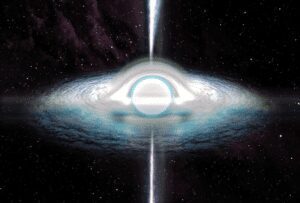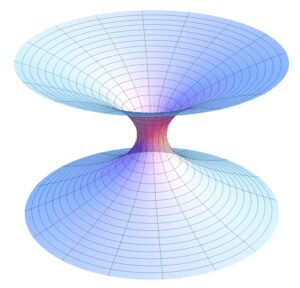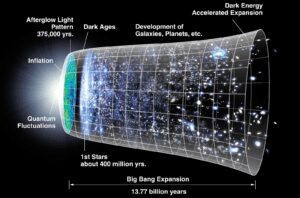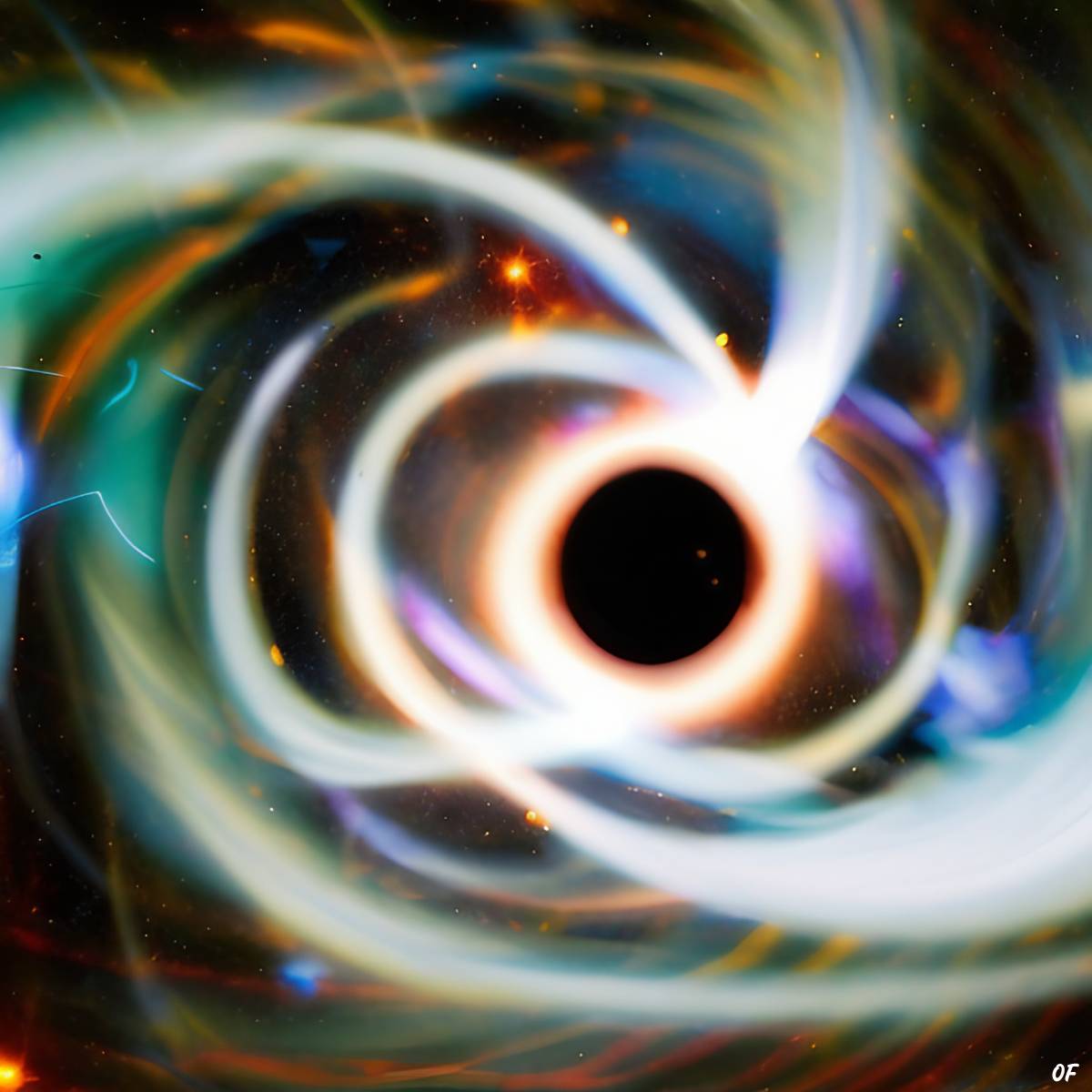Looking up at the night sky, you can see all sorts of features: stars, planets, moons, and galaxies, to name just a few. Much harder to see, however, is a black hole. As the name implies, these objects are completely dark, swallowing up light itself, and their existence was predicted theoretically long before astronomers found any through direct observation. Today, they are understood as some of the strangest objects in space. But what if something even stranger lies out there—a reverse image of a black hole, blazing with light rather than shrouded in darkness? If certain theories are correct, there exists just such a mirror: the white hole.

Back to basics: What is a black hole?
Black holes are a common sight in sci-fi, from Star Trek to Christopher Nolan’s Interstellar. But what are they, really? Some of them are the end result of the stellar life cycle, forming when a particularly large star—over 20 times the mass of the Sun—goes supernova, with the remnant collapsing under its own weight. Those are called stellar-mass black holes. Others, termed supermassive black holes, have millions of times the Sun’s mass, and are found at the center of galaxies—ours included. Their origin remains mysterious, but it is believed that they formed not long after the beginning of the universe.
Whether a black hole is small or large, it is defined by its immense, reality-warping density. There is so much mass compressed into so little volume that nothing can escape, not even light. The point of no return is known as the event horizon. Beyond that line, gravity is so strong that matter and radiation can only travel inwards. At the center, then, lies a singularity, where the normal rules of physics are no longer in effect, and spacetime itself breaks down.

A black hole singularity is necessarily invisible, given that light has no way to get out. We can, however, spot black holes using certain secondary effects. Light that passes nearby, without entering, is distorted by gravity in a way we can detect; furthermore, supermassive black holes such as the one pictured above—found at the center of the galaxy M87—will attract bright halos of gas around them, known as accretion disks.
Early theories
While it wasn’t until recently that we managed to “see” them, scientists have been investigating black holes for over a century. Karl Schwarzschild found a mathematical solution to Einstein’s equations just a few months after they were published in 1915. He predicted that if one compressed a spherical mass into a smaller and smaller volume, there would be a certain radius within which the force of gravity became strong enough to trap light, creating a region of total darkness. This radius is now known as the Schwarzschild radius, and describes the aforementioned event horizon.
Another solution: White holes
While Schwarzschild’s model created the conceptual basis for the black hole, later researchers found that it also pointed towards something else: a mirror counterpart, exactly inverting the object Schwarzschild had proposed. In 1964, Soviet physicist Igor Novikov first proposed the theory of white holes based on Schwarzschild’s work. Schwarzschild himself had died decades before, not long after he’d published his solutions to Einstein’s equations; the pace of scientific research had also been muddled by two world wars, hence the delay. Novikov’s thesis was that if you consider a black hole with no mass beyond the event horizon, you get a white hole: an object that cannot be entered. If a black hole is a bottomless pit, a white hole is an infinitely tall mountain. Nothing can ever enter it, and everything can escape—be it light, matter or information. A fundamental fact of the universe is that all mass attracts matter, but a white hole would have a repulsive effect, preventing any object from reaching its event horizon.
White holes and black holes
A few years before Novikov’s proposal, in 1960, American mathematician Martin David Kruskal stumbled upon an intriguing connection while he was working with Einstein’s field equations. Though he didn’t notice it at the time, his calculations predicted the existence of a counterpart phenomenon to the black hole; more than that, they showed that the two were directly intertwined. The specifics are difficult to understand without an academic background in math and physics, but the essential idea is that matter that goes into a black hole will eventually emerge from a white hole’s event horizon. The white hole might be somewhere else in the universe; it might be in the far future, or in the past, or in a different dimension entirely. This version of the white hole/black hole pair has them behave in a similar way to an Einstein-Rosen bridge—known more commonly as a wormhole.

How could white holes form?
There are numerous theories for how such a white hole could come into being. One is black hole evaporation. In the 1970s, Stephen Hawking realized that black holes emit a particular type of thermal radiation, later termed Hawking radiation. He hypothesized that, over time, this could lead to their depletion and eventual death. This created a paradox, however: under the laws of quantum mechanics and general relativity, information cannot be destroyed. The evaporation of a black hole would do exactly that, annihilating the “record” of everything that had fallen into it. So where does it all go? White holes offer an answer—perhaps the information gets thrown back out into space at the other end.
However, this situation is still difficult to explain under general relativity. The answer to this conundrum may lie with a newer paradigm, loop quantum gravity, which attempts to merge general relativity and quantum mechanics to create a “quantum theory of gravity”; it is a controversial, as-yet-unproven idea, but in this case it offers a clue. According to Carlo Rovelli of France’s Centre de Physique Théorique, loop quantum gravity might allow black holes to decay into ultra-low-mass white holes instead of disappearing entirely. Such microscopic remnants, each as small as a human hair, would still contain a record of everything that had ever fallen into them—solving the information problem. Long after the stars have gone out and black holes have withered away, these white holes would belch matter back out into an empty cosmos.
An explanation for the Big Bang
Other researchers have found the mysterious white hole not at the end of the universe, but at its beginning. According to physicist Hal Haggard, the geometry of the Big Bang bears a striking resemblance to that of a white hole—at points, they are mathematically identical. What if everything we see around us erupted out of a white hole 13.8 billion years ago? That white hole may have formed from a black hole in another universe, and in turn, the black holes we see around us today may create new universes in the future. It’s a bit of a chicken-and-egg conundrum. If the theory is true, though, it would have implications not just for astrophysics, but for some of the most fundamental questions of human existence.

Problems with white holes
The theory of black hole/white hole pairs may be fascinating, but the scientific community isn’t so convinced. Some believe that a white hole would be incredibly unstable. Outgoing matter would likely collide with matter in the white hole’s orbit, destabilizing the system and causing it to collapse back into a black hole. Despite this, the theory that the Big Bang was a white hole might still hold its ground—for an instantaneous event, you don’t need long-term stability.
Entropy presents another problem. The natural order of the universe is that structure descends into chaos. However, since a white hole is the inverse of a black hole, it can be postulated it could spew out matter to reform the original mass, essentially reversing time. This goes against much of our current understanding of the universe, and it is one of the main reasons why many scientists are skeptical about the existence of white holes.
What would a white hole look like?
From the outside, white holes might be almost indistinguishable from black holes, because their external regions of spacetime can be expressed by the same equations. The main difference would be that for a black hole, matter would accumulate at the horizon before falling to the center. For a white hole, matter would also accumulate at the horizon, but it would have originated at the center. Either way, an astronaut heading towards one probably couldn’t tell the difference.
It is also possible that white holes play by different rules entirely. Based on the possible association of the Big Bang with white holes, physicists Alon Ritter and Shlomo Heller argued in 2011 that a similar phenomenon might occur today in the form of a “Small Bang“, whereby all the matter explodes out in a short burst. These events create momentary flashes of radiation, only detectable in that precise moment; according to the authors, we may have already observed them, in the form of instantaneous, otherwise unexplainable gamma-ray bursts in empty space.
The future of white hole research
The general scientific consensus is not optimistic—white holes seem like an interesting mathematical solution that may be impossible in practice. But it’s worth bearing in mind that the same can be said for any number of physics concepts that were later discovered to be a reality; after all, it took over 50 years for black holes to be considered as facts. Excitingly, Ritter and Heller have presented a potential area for observational study—ultra-high-energy gamma-ray bursts—that could directly prove their existence. Perhaps the theory will be vindicated after all?


